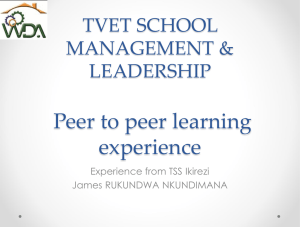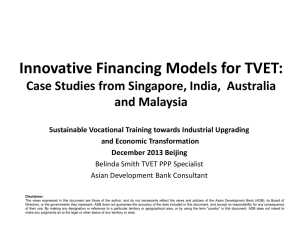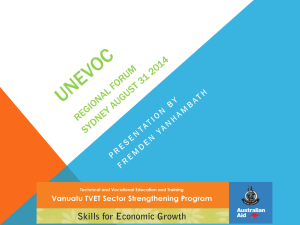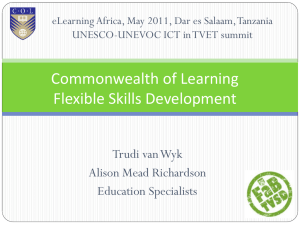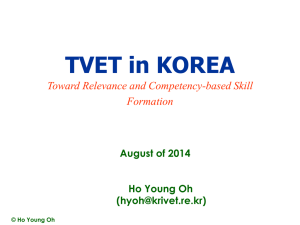Continental Strategy for TVET ST14525 _E
advertisement
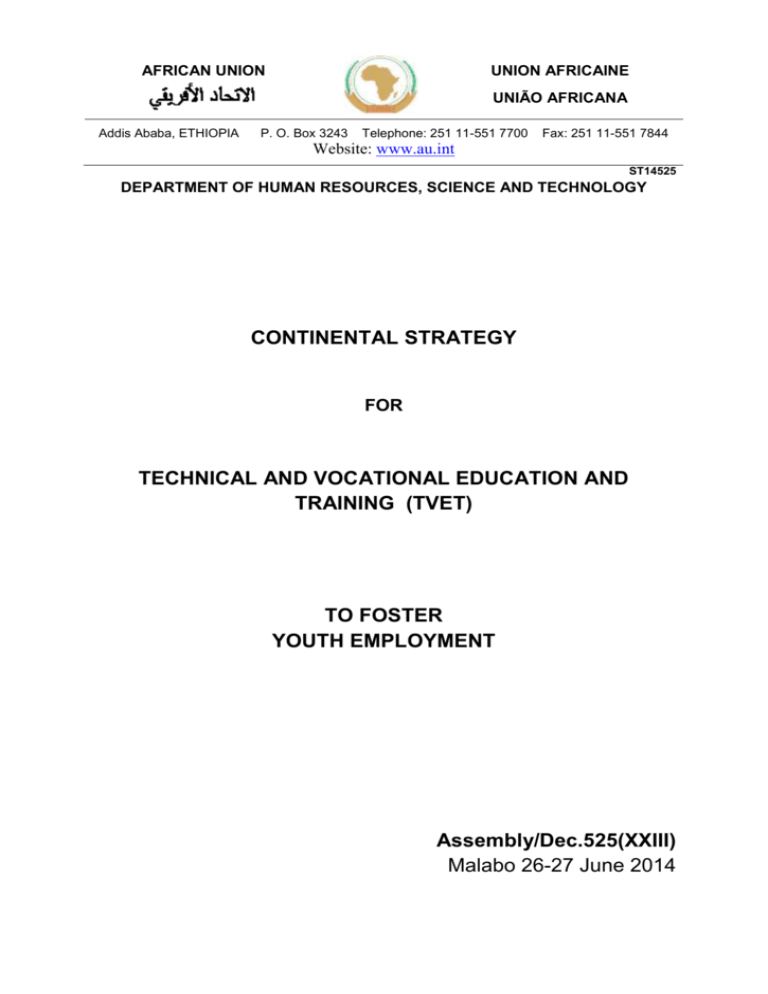
AFRICAN UNION UNION AFRICAINE UNIÃO AFRICANA Addis Ababa, ETHIOPIA P. O. Box 3243 Telephone: 251 11-551 7700 Fax: 251 11-551 7844 Website: www.au.int ST14525 DEPARTMENT OF HUMAN RESOURCES, SCIENCE AND TECHNOLOGY CONTINENTAL STRATEGY FOR TECHNICAL AND VOCATIONAL EDUCATION AND TRAINING (TVET) TO FOSTER YOUTH EMPLOYMENT Assembly/Dec.525(XXIII) Malabo 26-27 June 2014 Page 1 FOREWORD . The issue of Technical and Vocational Education and Training (TVET) is important enough to stimulate the production of a strategic document that will be difficult to read, and consequently become more complex to implement. Page 2 1. Introduction The growing problem of youth unemployment and underemployment is one of the main socio-economic development concerns of most African governments. Without job-related skills, youth and adults cannot benefit from the employment opportunities that offer a decent income. In many countries, one of the key elements of development strategies is to support young people to acquire professional skills through Technical and Vocational Education and Training (TVET) programmes. This approach also helps to promote entrepreneurship. It was in this context that the African Union Commission (AUC), in 2007, developed a continental strategy to revitalize TVET in Africa. At the time of drawing lessons from the mid-point assessment of the 2007 strategy, the need was felt to review it and redefine our vision of TVET in order to improve its visibility so that it can better play the role assigned to it. Africa certainly has high economic growth rates, but paradoxically this growth does not translate into jobs, and unemployment rates are not falling. The consequence is that African economies are struggling to cope with the difficult task of providing decent jobs for the millions of new entrants to the labour market (estimated at about 10 million) each year. The increasing number of poorly educated, unskilled and unemployed young people every day becomes a threat to the stability of countries and therefore to their development. It is estimated that almost 100 million young men and women in Africa, out of a total population of about 200 million young people, are illiterate and unemployed or in low-paid jobs (UNESCO, 20121). Consequently, the quality of the workforce remains low and often inadequate. In the formal industrial sector, declining employment opportunities remains a concern and work in this area is less than 10% in most African countries (Filmer et al., 20142). The vast majority of the workforce is found in the services and agricultural sectors. This workforce distribution pattern must be considered when developing national policies, TVET strategies and training programmes. While wars, conflicts and other natural disasters have destroyed the provision of TVET systems in countries in conflict or post-conflict, which unfortunately are too many on the continent, the TVET system in many countries is characterized by obsolete or damaged infrastructure and quantitatively and qualitatively insufficient human resources. This is due to the death or displacement of experienced instructors and other workers who are very often not replaced. 1 UNESCO, 2012. Youth and Skills- Putting Education to Work. EFA Global Monitoring Report Filmer, D. Fox, L. Brooks, K. Youth Employment in Sub-Saharan Africa. Published by the French Development Agency and the World Bank. 2 Page 3 2. General Considerations: Technical and professional skills capacity building systems in Africa are hampered by poor relations with the labour market, lack of trained personnel and inadequate programmes. Very few countries lay emphasis on capacity building in rural communities and recognize the role of the informal economy, which is the largest employer and the main source of technical and vocational education in Africa. First, it should be understood that the acquisition of technical and professional skills can take place in different learning environments. These include: - Formal learning, which is synonymous with school or curriculum-based learning; Non-formal learning and finally; Training based on informal learning. In some parts of Africa, the informal sector accounts for over 80% of all training skills (ILO, 20073). Training in the informal sector is more flexible than TVET in schools that imposes rigid admission criteria and age limits for learners. Teaching in the informal sector very often takes place in the local language, in a culturally friendly environment for illiterate or poorly educated learners. It is therefore important to strengthen the provision of TVET in the informal economy, especially the traditional apprenticeship system where master craftsmen transmit their knowledge to the younger generation. a. TVET Landscape: The Current Situation Fragmented delivery of TVET TVET delivery in Africa can be divided into three broad categories: i) ii) iii) public technical and vocational institutions belonging to the State; private vocational training institutions; and traditional apprenticeship. The fragmented delivery of TVET in Africa has important implications for the quality of training, standards and comparability of qualifications (certificates) issued. Some private providers issue their own certificates and diplomas that are not calibrated with national standards. The multiplicity of qualifications and professional certificates of dubious quality does not improve the image of TVET. Unregulated traditional apprenticeship In many countries, traditional apprenticeship remains the dominant pathway for skills acquisition among youth leaving school or dropping out. However, because the learners and their trainers are often poorly educated, skills development in the informal learning sector is rather slow to embrace modern technological practices, hence perpetuating the use of traditional learning methods (sometimes outdated). Growing importance of private TVET centres In almost all countries, TVET delivery outside the government is increasing in terms of the number of both institutions and of learners. This trend is related to the 3 ILO. 2007. Apprenticeship in the informal economy in Africa. International Labour Office, Geneva. Page 4 fact that private providers give training for the informal sector (which is an expanding labour market throughout Africa), while public institutions train mainly for the formal industrial sector, which is more or less stagnant. TVET systems are still supply driven Although considerable awareness has been created on the need to make TVET demand-driven, the reality in many countries shows a TVET delivery system often inherited from the colonial era which is predominantly focused on supply. The development of non-target skills is a major weakness of the TVET system in many African countries. Training institutions do not follow the employment destination of their graduates. Consequently, the valuable input of former trainees on the quality of training they received and the opportunity to take into account the contributions based on their experience when revising programmes and training modules are lost. Mismatch between supply and demand for skills The phenomenon of "unemployed graduates" is widespread in Africa. In many countries, a large number of graduates from the formal school system, including university graduates, are unemployed, although the economy still has opportunities for skilled workers. This situation has highlighted the mismatch between training and labour market demand for skills. Little prestige and attractiveness of TVET In many countries, technical and vocational education is still considered by parents, the public at large and even some politicians as a domain for less academically gifted students. This perception was fuelled by low academic requirements for admission into TVET programmes and the limited prospects for continuing education and professional development for TVET graduates. Geographic and economic disparities, Economic inequality is a greater barrier to participation in education and technical and vocational training than that related to sex. In many African countries, the children of poor parents are unable to pay the fees charged by training institutions. Invariably, good technical and vocational schools are located in cities (especially the larger ones), thus limiting access to quality education and skills for people in rural areas. Gender-based inequality of opportunity Women and girls are still not adequately represented in the professional sectors, which are traditionally reserved for males. Low quality and ineffective training The quality of training is related to the issue of skills mismatch. In general, the provision of TVET places too much emphasis on theory and certification rather than on skill acquisition and aptitude tests. Inadequate training of instructors, obsolete training equipment and lack of training materials are some of the factors that combine to reduce the effectiveness of the training to meet the objectives of knowledge and skills required by employment market standards. The poor quality and inefficiency of training led to a situation where the labour market looked outside for skills. Often we helplessly witness a sometimes abusive import of external expertise to the continent whereas they could be trained locally. Page 5 This practice which results in a net loss of new jobs at the expense of local ones is becoming increasingly frustrating. Insufficient funding Only a few African governments currently finance TVET at a level that can sustain quality training. TVET is generally expensive in terms of cost per student. However, this is not reflected in the budget allocation of the TVET sector. Policy and legislation One of the main weaknesses of the TVET distribution system in Africa is the fragmented and uncoordinated nature of the delivery service. Instead of a unified policy and legal framework, TVET in many countries is organized under various ministries and government departments and is governed by different legislative instruments themselves managed in different structures. Addressing these institutional challenges should be at the heart of current policy and governance reforms underway in many countries. Weakness of policy implementation structures The proliferation of structures responsible for the implementation of the management of TVET policy and the dissemination of monitoring responsibilities among various ministries and government structures account for some of the system's inefficiencies. These include duplication, segmentation of training and the lack of a common platform for a coherent development of policies and joint initiatives. Promising initiatives at national level Some promising TVET policy reforms are underway in a growing number of countries. This is demonstrated by the active participation of the private sector in the TVET system, the current resilience and renovation of the traditional apprenticeship system, the creation of national bodies with oversight of training and the enactment of laws to strengthen the education and training systems. - Working closely with training schools and trainers for the formulation of the current needs for skills in relation to market expectations; Offering industrial location and workplace options as well as experiential apprenticeship for learners. b. Summary Assessment of Past Strategies: i- Second Decade of Education in Africa In its Plan of Action for the Second Decade of Education (2006-2015), the AU recognizes the importance of TVET as a support mechanism for economic growth and as a means of empowering people to establish sustainable livelihoods. The Second Decade of Education (2006-2015) stipulated that its goal was to rethink the educational systems of Member States of the African Union so that young people will receive compulsory basic education aimed at equipping them with essential general skills, qualifications and attitudes leading to a continuing education culture and an entrepreneurship spirit so that they can adapt to a constantly evolving world of work. Page 6 To meet labour market demands, quality TVET should be designed and delivered by institutions and other providers in close collaboration with potential employers. The aim is not only to change the behaviour of parents, teachers and the public vis-à-vis TVET but also to promote the sector as an essential component of the education system focused on preparing learners for all labour levels through specialized technical training. In this respect, a reliable TVET programme should be based on: - Solid general education; Reliable basic general/technical education, notably including communication programmes, entrepreneurship and learning practical life skills; Specialized technical training. Given that many young people are not in the formal school system, nonintegrated institutional learning consisting of literacy and TVET programmes, especially for girls and women, should promote the well-being of communities across Africa. TVET also offers a framework for the preservation, promotion and development of knowledge as well as cultural and artistic expressions. TVET will therefore be a high priority investment sector during the Second Decade of Education in Africa. The following priority areas will accordingly be addressed: - Equitable access to TVET for all; Quality and relevance of TVET systems and programmes, increased private sector involvement and funding; Increased resources for TVET to acquire modern equipment and facilities; Integration of TVET in literacy and non-formal education for vulnerable groups and reconstruction in post-conflict situations; Capacity building, especially the mobilization of TVET teachers. Unfortunately TVET has not been adequately applied in African countries. In cases where such programmes exist, they do not take sufficient advantage of modern technological facilities. A strategy was developed in 2007 to stimulate this process and make it more efficient. However, although the 2007 strategy was generally accepted by policy makers and key stakeholders, there has been little progress in its implementation. This lack of concrete actions at national level was attributed mainly to financial and human resource constraints as well as to limited or insufficient political commitment for action based on a clearly defined national or regional plan that can become law. However, a number of partners and AU Member States were inspired by the 2007 Strategy to introduce national and regional TVET activities. The African Union Commission too, implemented TVET programmes in countries in post-conflict situation such as Liberia, Congo Brazzaville and Burundi, with mixed results. Page 7 iiNeed for a New TVET Strategy (2007) Since the formulation of the 2007 strategy, new developments, perspectives and approaches to TVET as a means of addressing the critical issue of youth unemployment have emerged. The review of the 2007 Strategy identified the need to align it with current global trends and define a set of indicators for monitoring progress. The revised strategy takes account of concrete recommendations to address policy issues, challenges and gaps that often interfere with the implementation of many initiatives and skills development programmes on the continent. This is what gave rise to the idea of this new continental strategy that more thoroughly examines the response possibilities of TVET to facilitate the promotion of national development, social cohesion, political stability, poverty reduction and regional integration. It draws on recent regional and international initiatives aimed at promoting TVET to foster youth employment. 3. Conceptualisation Reasoning at the triple national, regional and continental levels requires a simple and effective policy to harmonize the different concepts which essentially involves finding a commonly accepted terminology. Apart from this chapter, it has sometimes been useful to clarify the meaning of words to illuminate the understanding of the strategy, especially around the issue of jobs. a. TVET There is an ongoing conceptual debate on the definition and meaning of different terms used to describe the acquisition of employable skills. Terms such as "education and vocational training" (EVT), "technical and vocational education" (TVE), and "the development of technical and professional skills" (DTPS) are used in different countries and different contexts to mean "Technical and Vocational Education and Training" or TVET in all its dimensions. In this paper, the term TVET is used in its broadest sense to cover all aspects of training and skills development and training of all cadres, whether formal, nonformal or informal. It also includes the issues of demand and supply of skills, employability, improving skills, ability for self-employment, and retraining, versatility and continuing apprenticeship. Concerning the scope of TVET from primary school to higher education, it is a mistake to consider TVET as a separate sector rather than an integral and final purpose of any education system that leads to the acquisition of knowledge and expertise relevant to society and the development of the individual. TVET must be seen in a cross-cutting manner and understood as extending from primary education to higher education. Therefore, from primary school students should understand firstly the importance of exercising a professional activity within society and secondly that the Page 8 education system in general is a place for acquiring basic or otherwise generic skills. The difference is that certain professions (engineer, doctor, lawyer, etc.) require more or less wide basic theoretical knowledge (intellectual background). But the fact of learning the trade and acquiring more and more experience with daily practice and over time is common to all professions, from the mason with his trowel to the civil engineer. It is quite remarkable that in many African countries, training is already attached to the Ministry of Higher Education. This is a signal that cannot be ignored. b. Types of Training It is important to make a distinction between the three types of training that are the Formal, Informal and the Non-Formal. i- Formal The formal framework is understood here to refer to the whole system governed by precise rules laid down. This is essentially training in public or private schools with fixed-term cycles and crowned with a state diploma or certificate. TVET systems in Africa vary from one country to another and are taught at different levels in different types of schools, including technical and vocational schools (public and private), polytechnics, businesses and apprentice training centres. In almost all African countries, formal TVET programmes are found in schools. The formal TVET at the second cycle of secondary education normally lasts for a fixed term, is supply-driven and has a high unit cost. ii- Informal In the informal case, training is given in structures organized or not with their own rules of trade that often exist without being written or formalized. The following can be grouped here: - - Corporate training according to objectives and terms of reference that may vary or not depending on demand and including retraining, apprenticeship and continuing training; Training by companionship in workshops or not, often structured around a master craftsman with journeymen and apprentices; Training in the crafts, whether traditional or modern; The end of training certificate is conferred by the recognition of master craftsmen grouped for this purpose or not. iii- Non-formal The framework is considered to be non-formal when: Training obeys no rules and may be spontaneous. On-the-job training for the benefit of daily practice on the ground falls into this group. Page 9 This sector is still the most open, otherwise it is subject to creativity and innovation. c. Productive Sector Beyond the importance of the private sector where it is advantageous to promote initiatives, the fact cannot be ignored that most often in Africa, it is the public productive sector that is predominant. It is therefore assumed that the productive sector within the meaning of this strategy includes the public productive sector, the private sector, handicrafts and the traditional sector: all producers of goods necessary for socio-economic development. 4. Vision and Mission (of the Strategy) a. Vision of the African Union The vision of the African Union (AU) is that of a "an integrated, peaceful and prosperous Africa, driven by its own people to take its rightful place in the global community and the knowledge economy". It is a major advantage that this vision is therefore based on the development of the human resources of the continent. b. TVET Mission In recent years, given the rapid technological advances taking place in the labour market, it has become necessary to integrate flexibility, adaptability and continuous apprenticeship in training supply. One of the most important developments in the TVET sector in recent years has been a paradigm shift that results in a more holistic policy in favour of the sector making it possible to adopt and recognize the acquisition of skills in all areas of training and/or learning, be they formal, informal or non-formal as noted above. TVET should be a coherent system whose purpose is to meet the continent's economic development demand in terms of skilled human capacity both in sufficient quantity and quality to support human activity needs. TVET should stop seeming like or being considered as a simple combination of provider structures comprising: - Technical and/or vocational institutions from primary school to the public higher education level as well as private institutions that abide by all the rules; - Private vocational training institutions with their own organizational and operating rules and their own certification systems that are not calibrated to standards recognized at both the national and international level. Often these institutions respond spontaneously to some labour market demand; - Various traditional learning structures. Page 10 The main objective of Technical and Vocational Education and Training is not only to provide skills to gain paid employment but also to encourage and support creativity, innovativeness and entrepreneurship in order to create one’s own job. The need to link training to employment (self-employment or paid employment) is at the heart of all the best practices and strategies observed worldwide in TVET. c. Strategy Mission The mission of this strategy is to build a unified general framework that can serve as a continental platform around which AU Member States will cluster and/or be invited to build TVET coherent and integrated systems at national, regional and continental levels through the development and implementation of national and regional plans. This will be done to ensure a network enabling: - genuine standardization in TVET; recognition and harmonization of training; mobility of players, especially teachers. The mission of the current continental TVET strategy is to position TVET within the education system as a tool for the empowerment of African people, especially young people as a culmination of all the training needed for the socioeconomic development of the continent. The main objective of the strategy is to promote not only skills through training focused on the response to the demand of socio-economic activities through employability tests, sustainable livelihoods and responsible citizenship, but also capacity building to create and innovate, thanks to the entrepreneurial and initiative spirit. The major objectives of the strategy can be summarized as follows: 5. Promoting an efficient and cost-effective system of quality TVET; Ensuring the relevance of training and employability of trainees; Developing creativity, innovation and entrepreneurship; Improving the legal and political environment as well as coherence and management of training provision; Promoting continuing apprenticeship; and Strengthening the status and attractiveness of TVET. Approach Based on a Paradigm Shift a. Question the demand and not simply be satisfied with the supply of training Having accepted that the starting point is not the supply of training that proved inadequate and has produced unemployed graduates but rather expressed or latent demand of the economic system in general, the approach adopted here starts with Page 11 simple questioning about skills needs of sectors of activity that are engines of a country’s economy. The intention here is therefore to present a strategic framework and a set of practical recommendations to inform policies, strategies and action plans aimed at appropriately promoting the quality of Technical and Vocational Education and Training. The diagram below shows the basis for the development of a coherent national or regional TVET plan. from the fragile vegetable in the garden of the small African farmer Trades Curricula Training of trainers Training of job creators rather than job seekers at all levels (from primary to higher education, including the informal sector) Required infrastructure and equipment Financing What has been the road covered ? So many jobs to create! Here is HOW TO DO IT! To the table Of the Head of State and Government Or of Mr. and/or Mrs. Everybody Multiply this image for all sectors of activity in a country based on - High value added sectors; - The effective industrialization of the continent; - The green economy and the blue economy - Innovation Not only in the development of its local natural resources but also taking into account the state of technology worldwide with special attention on emerging technologies. = National TVET Plan (Technical and Vocational Education and Training) Based on - A paradigm shift in TVET - A clear implementation mechanism - Indicators enabling dynamic and ongoing assessment In close collaboration with - a National Employment Plan for Young People in particular expressing the demand of the productive sector (Plan to be developed if it does not exist) One of the most important developments in the TVET sector in recent years has been a paradigm shift making TVET a more holistic policy to adopt and recognize the acquisition of skills in all learning frameworks - formal, informal and non-formal. Page 13 This example of a vegetable that can and should be multiplied was chosen because among other recent developments in the TVET sector, there is training for agricultural skills throughout the entire agricultural value chain, from input supply to food production, through treatment and processing, marketing and consumption. TVET strategies explore more new opportunities offered by globalization, technology and advances in new production systems. Agriculture including food production is the largest employer in Africa. The path chosen here also resorts to primary care in the garden, needed water supply, picking, packing, processing, transportation, marketing and cooking and many other things too numerous to mention such as problems induced by energy, etc. To illustrate the path taken by the vegetable, the image of the pyramid from the wide base to the peak summit was not used to avoid giving the impression that the one who, at the end of the chain receives vegetable on the plate, is the most important part of the circuit. Similarly the top of that chain might feature personnel responsible for setting the dining table and cutlery, providing cooked meals, clearing the table and washing the dishes. That many jobs created on this course! This is demonstrated in all areas of production of all kinds (from our plantations to our diamond and gold mines, our workshops to our industries), and this structure is more than necessary to revisit the training objectives for young people and redefine the role of the training institutes and centres and all actors involved, from near or far, from the design to the implementation of TVET, through its funding and institutional management. b. Productive Sector As the end user of the TVET product, the productive sector should be involved in the training process at the stage of defining the demand. 6. Trades a. Trade Determination It is appropriate to remember and to keep in mind that there are no stupid trades, but stupid people, and that human activity that allows one to practice a profession gives meaning to life. Even beyond the observation of the unfortunately increasing phenomenon of unemployed graduates, we often hear the claim that this is due to the fact that "ONE LEAVES THE UNIVERSITY WITHOUT A JOB". In terms of social activities, the trade is defined by its purpose and refers to the techniques and tools whose expertise and control require a learning experience, while the profession, which is characterized by a specificity that may fall within a legal framework, refers to paid work exercised regularly for a living. We speak of "livelihood". Page 14 Although one may have several trades but for lack of opportunity one cannot carry out the one in which one would have liked to excel, the trade determines the profession in terms of technical skill acquired through practice and the experience from a professional activity. There we talk of having a trade in a profession. Similarly, because of its reference to payment, it is the profession that confers a more or less prestigious social position. We also talk about chamber of trade or profession to qualify all persons exercising the same trade. They often endeavour to establish the rules of practice and promotion of the profession according to a certain ethic. This evokes the orders of trades or professions: Order of lawyers, engineers, interpreters, doctors, etc. The concept of trade in TVET should, as in other areas, include developing the trade, through which we can derive both individual gain and collective profit. Indeed, in the description of the social utility of trade, important dimensions such as the shared social value and the collective and individual responsibility make it possible to ennoble the contribution of each and all for the achievement of common development goals. This easily gives rise to the construction of the solidarity chain of human activities and between humans. b. The Quest for Socio-economic Development and the TVET Response This raises the challenge of matching training and employment which cannot be viewed as the problem of the chicken and the egg. The wording and/or expression of the quest for socio-economic development in human resources should be in terms of quantity and quality through planning even if it should be flexible and indicative. Such planning will help promote the trades of the future and assess training needs. In terms of TVET response, the definition and description of trades remain essential to the identification of training needs, the expression and development of the content of these courses and relevant curricula they require. Such work will be done if necessary by establishing the difference between trades and careers or professions that compose them. To enhance the attractiveness of TVET and trades for which it trains people, the work of defining and describing such trades must largely involve personnel of the school and university guidance services. This information should be relayed by all communication networks, indicating the following elements: The importance and necessity of each trade through its place in the production chain and how it can be sought; Career and opportunities for career advancement within a company or through continuing training; Training based on qualifications sought in terms of years of education and/or training as well as the possibilities of crossing from one level to the next as listed below, for example; Page 15 - Labour (Highly) skilled worker Foreman Executive and/or design engineer Manager Profiles and the related programmes should easily ensue. 7. Programmes and Curricula Once trades are defined and clearly described, the objective of programmes and curricula is to organize training for a duly recognized qualification. Training therefore becomes an intentional and educational intervention with a set of knowledge in a given field. The training content is consciously developed based on an identified need, taught by professionals at an audience of beneficiaries who wish to improve their knowledge and skills in that area. At the end of the training, qualification is determined by evaluation based on set standards. Clear links must be established between the different levels and types of training. a. Generally i- Description and Methods of Acquiring Skills As is the case with all learning processes, the path will go from the most simple to the most complex, taking into account, of course, all the basic and/or related knowledge necessary for the proper ownership of the subject. Definition of Training Programmes and Courses The main objective of TVET programmes is to enable the acquisition of knowledge, skills, abilities and attitudes in the trade or a professional field in order to draw a dignified and justified remuneration. These programmes take on board the generic skills, specific skills and related skills. It is this body of knowledge that allows not only clever and just handling of more or less complex tools, but also practice ensured by proven experience. This is known as technical skill. Training programmes should, at all levels, give an important place to the teaching of pure or applied mathematics. Similarly, a special emphasis will be placed on the teaching and development of science and technology. The language of learning also deserves special attention in order to facilitate communication and especially the ownership of lessons. ii- Training Programme Management Mechanism Page 16 It is essential for programmes to be regularly adjusted in order to adapt training to technological changes. Mechanisms related to the observatory monitoring the state of technology must be put in place to track such changes. b. Innovation, Creativity and Risk Invention and innovation are technical or organizational responses to problems arising explicitly or latently. Invention capacity also contains a large proportion of anticipation. It is necessary for TVET students to be trained in intellectual property. They must have knowledge of invention and innovation, and be aware of what it is, its scope, usefulness and importance in technological development and the world of production. They must realize that inventing or innovating are within their reach and they are capable of doing it. Students should be trained in the use of patent information to know the state of the art and technology and seize opportunities to improve or adapt them to their situation. Being assured of the possibility of exclusive use of one’s invention for decades is in itself a major asset of motivation. National authorities must take appropriate measures to make intellectual property more accessible to all. The media in turn must be called upon to ensure the development of such a culture of innovation through a wide dissemination of information on the issue. Understanding innovation, creativity and the necessary risk entailed means being able to: Design, analyse and synthesize; Translate knowledge acquired into everyday practice; Use innovative and appropriate technology; Express creative and innovative thinking; Develop, plan and conduct research; Use patent information, particularly with regard to technical advances and patents in the public domain; Adapt to become an agent for the acquisition of new technology; Create new technology; Accept a little craziness and the courage of one’s ideas. The sense of innovation and the spirit of creativity should become part of the learning outcomes to be maintained throughout life: during and after training in daily activities. Invention or simply innovation sometimes uses what is called a touch of madness that helps overcome the risks. TVET students need to be prepared. Training institutions should be able to submit entrepreneurial and profit goals, thus providing learners with opportunities for innovation and creativity. Page 17 c. Knowledge of Corporate Life i- Corporate Culture Internships in the productive world are the essence of TVET. They are the basis of a true corporate culture. Very often, this type of training is called Work-Study Alternation. It allows the learner to acquire skills related to his chosen trade. Within the context of the work-study alternation, part of the training is done in the workplace and involves more than a training internship. The objectives, the number, timing and duration of the courses are then determined jointly by the school and the company. Trainees are necessarily associated with activities and usual business operations. These courses are generally longer and more frequent than traditional refresher courses and require greater participation of host companies. This type of organization better prepares students to enter the labour market, but also allows the school to better identify the training needs that programmes must meet. The training courses provide invaluable knowledge of the reality of the production environment. As is commonly found in higher education, there is no such lawyer who has not spent part of his qualification time in a law firm or no general practitioner or specialist physician who has not been an intern in a hospital to become familiar with the life of the profession. And in this sense, the examples abound. With their modern facilities, TVET institutions can directly involve their students in business life. Indeed, they may be asked to bid for tenders to provide some paid service to companies, often in the field of maintenance. ii- Establishment and Management of a Business In their training course, learners will be informed about the classification of companies and must understand the procedures for their establishment. They will be trained in the development of administrative records required for the creation and management of a company. They will be prepared to deal with, as appropriate, the risks entailed. In any case, accompanying measures should be implemented to bring them to take the first step. d- Research in the TVET Field TVET development should be placed at the forefront of technical information to keep abreast with technological developments across the continent and the world. TVET itself then becomes an object of research putting production lines at the centre of development in order to acquire the ability to anticipate that is always needed in the education system. Through such research, TVET teaching will be constantly reviewed. Page 18 8. Training of Trainers It is important to keep in mind the Master-Learner-School triptych. The teacher is an essential element in the knowledge transmission process especially when the concept of demonstration of daily practice in the profession occurs. His example becomes a life lesson for the learner and his personal success is reason to believe for those who want to follow him. This is why the training of teachers in sufficient quantity to provide the necessary critical mass is as important as the quality which itself brings in a harmonization assurance and therefore mobility. Well trained teachers or trainers themselves in quantity are not enough because we have to think about providing them with conditions of work and life that inspire them confidence to continue doing work that is not a source of resentment and daily frustration. With well trained teachers in sufficient quantities, TVET institutions can be managed. In this respect, a new class of school managers having received proper training and the skills of business managers will be trained. This will give them the ability to more easily get in touch with the leaders of the productive sector. It is important to remember using collaborative teaching strategies involving the learner and the teacher in the learning process. 9. Paradigm Shift Making the paradigm shift in TVET means developing the idea that TVET prepares young people to become job creators rather than job seekers. This will put an end to the idea that, without recourse, it is the scrap of general education that will be found in TVET. That is already visible with the many liberal professions being opened with skills training. a. State Responsibility The primary role of the State will be to understand itself that an education system with no trade and therefore no assurance of professional qualification is simply unfinished. The second is to have the political will to act accordingly by improving the environment around TVET. As much as it is necessary to stop the brain drain to developed countries, it is equally important to avoid the phenomenon where those who do not go out tragically witness the fact that the jobs created in Africa are mostly occupied by imported and more qualified human resources with expertise and corporate behaviour sought by private entrepreneurs in particular. Page 19 b. Responsibility of Parents and the General Public The change of mentality and view of TVET relates largely to parents and therefore the general public. It is up to parents and the family (African) as a whole to build around them all the confidence young people need in the perception of TVET. They must be on hand to support their children when making the decision to enrol in the TVET system to learn a trade, regardless of the type of training chosen. c. Responsibility of the Productive Sector The productive sector has to understand that its own development depends largely on TVET quality and should to that end set an example by partnering fully in TVET development. By giving a strong signal that consists, among other things, in opening its doors to students during and after their training, the productive sector will contribute to enhancing TVET. d. Responsibility of Learners Themselves Whatever the level, TVET is a guarantee for the future. The workshop training image could be remodelled to galvanize learners. Indeed the dream of the young apprentice who enters the master's workshop is to become master himself the day his master will give him the rank regardless of the ritual. This gives the pupil entering TVET the idea if not the dream of becoming his own boss tomorrow. The idea itself is new, and helps to inculcate in all the TVET paradigm shift: "Enter the school with the idea that when leaving there, you will become Your Own Boss". 10. Infrastructure and Equipment As previously reported in the review of the current situation mentioned above, in most AU member countries, when modern TVET institutions exist at all, they are in disrepair and without adequate equipment. In this case, the new TVET infrastructure called for by this continental TVET strategy should be a revealing and highly visible element of the revolution to be ushered in by the will for a paradigm shift in TVET. In the current configuration of most AU member countries, it is understandable that it is naturally the State to take the initiative and lead the way. Therefore, the standards that will be adopted in the implementation of the new TVET policy will be followed by all, without recriminations, and will be the pride and concrete recognition so much needed by the TVET sector. If the whole point can be presented schematically by the following three equalities: TVET = Trade Page 20 Trade = Practice Practice = equipment and adequate teaching materials The importance of infrastructure with equipment and adequate teaching materials for TVET will be realized better. There is the argument that TVET often requires equipment whose use is not optimal with a very low rate of return. The fact is that the profitability is certainly unclear while the issue could be resolved through good pooling of such equipment between TVET institutions or leasing of usage time to the productive sector. This approach strengthens partnerships with the productive sector, and contributes even more to the strengthening of entrepreneurship, the development of the cooperative spirit and its management, especially in cases where learners are directly associated. 11. Financing a. Financing Employment and/or job creation and TVET should be closely linked. TVET sector financing should therefore be considered as part of the responsibility of the whole society, especially the productive sector, both public and private. In this regard, employers should be required to contribute financially to the national training fund to support the development of national expertise and professional standards in accordance with labour market needs. b. Financial Support Mechanism The issue of start-up funding mechanisms is a key enabler to overcome inertia and the fear of adventure of the young people who want to create their own jobs. The mechanism will be built on the following basis: - Establishment of a business and job creation support fund (SMEs, crafts, etc.); Encouragement and support for research in the field of TVET and innovations relating thereto, including occupations of the future; Financial contribution of employers to the national training fund; Contribution to the financing of post-training support services; Support for multiple advocacy initiatives, motivation campaigns and TVET programmes; Fostering of partnerships in TVET-related areas. 12. Governance a. Role of the AUC The African Union Commission will play the following role vis-à-vis member countries: - Raise awareness among governments on the transformational role of TVET for socio-economic development; Page 21 - Invite member countries to develop national plans when they do not exist; Provide technical assistance to Member States in need of such assistance; Develop regional policies, particularly regarding training of trainers by liaising with national plans; Promote TVET as a vector of regional integration; Actively play an advocacy role for TVET within the international donor community; Supervise the implementation of the strategy at the continental level through indicators. b. Role of Regional Economic Communities (RECs) Regional coordination calls for action by the Regional Economic Communities (RECs), which will include: Creating a platform to help coordinate the activities of institutions active in TVET in States of the Region; Sharing the TVET Strategy Paper with Member States in the Region; Encouraging intra-African and regional cooperation in the field of education and training; Appealing to the African Diaspora to support TVET in Africa; Identifying, documenting and disseminating best practices in Member States; Serving as AUC relay and continuing to raise awareness of governments on the transformational role of TVET for socio-economic development; Boosting communication and constant and active advocacy efforts in support of TVET in the international community of donors; Providing technical assistance to States as required and in partnership with the AUC; Promoting TVET as a vector of regional integration; Monitoring the implementation of the regional strategy and reporting to the AUC; Conducting a review and peer analysis of national TVET systems. c. Role of Member States The role of Member States is to strengthen guidance and counseling services for trainees and create a TVET quality supervisory authority (within the TVET observatory). The first condition for the successful implementation of a national TVET strategy is the development of a national TVET policy that sets out the Government's vision for skills development. Then it is necessary to define synergy between the national and regional plans, continental and beyond, in order to better support the diversity of trades of the future. Each country will define and clarify the lines of clear articulation between TVET and other sectors of the national economy. Another condition of the implementation is to ensure that the national TVET strategy is consistent with regional and international frameworks of existing education and training policy protocols. Page 22 i- Institutionalizing the place of TVET Meeting the institutional challenge of TVET governance should be at the heart of policy and reforms in favour of TVET. This involves first drawing up a legal framework and a unified TVET policy that also takes into consideration the following factors: - Organization of the private sector, particularly the TVET informal sector; Definition of consultation mechanisms at the three levels: national (country), regional (RECs) and continental (AUC); Direct involvement of parliaments of member countries; Creation of a TVET quality supervisory authority; Establishment of a clearly empowered strategy implementation body. ii- Role of Government It is the Government’s duty when taking the initiative of a national TVET plan to: - Provide legal support for national TVET policies; Increase financial support to the TVET sector and improve investment in TVET; Establish TVET management information systems for education and training, including labour market information systems; Introduce measures to reduce gender inequalities as well as economic and geographic discrimination in the provision of TVET; Establish sustainable financing mechanisms for TVET; Set up a venture capital structure to support learners at the end of training and enable them to create their own jobs; Strengthen leadership and management capacity of the TVET driven system; Build a harmonized system of recognition/certification of skills; Constantly monitor and track progress in the TVET delivery system and periodically apply appropriate remedies. Simplify business creation administrative procedures; Build technology halls and business incubators. Appropriate policies and procedures need to be developed and implemented for these goals to be achieved. A number of approaches are recommended and cover the following key policy issues: Improving the political environment and management of TVET; Promoting the paradigm shift in TVET to foster the spirit of enterprise, initiative and innovation; Upgrading the informal TVET sector; Promoting skills in the areas of agriculture and rural development; Training for the green economy and emerging job markets; Assurance of delivery quality; Promotion of ICTs in TVET; Enhancing relevance and employability; Strengthening partnerships and relationships with the private sector; Page 23 Engagement with major economic, political and international players; Promotion of higher level skills; Diversification of funding sources and sustainable financing; Enhancing the image and attractiveness of TVET; Improving access and participation of women and vulnerable groups; Monitoring and evaluation of TVET systems; Promoting research in TVET. iii- Role of Parliament As an institution that votes the State budget, Parliament must be involved at all levels to require the development of national TVET plans and ensure that they receive the necessary financial resources for their implementation. iv- Role of the Productive Sector The paradigm shift goes hand in hand with that of the place and role of the productive sector for TVET. It is therefore essential that the productive sector fully play the game. It cannot remain in the role of seeing that the TVET product is unable to meet its needs without ever participating in the standard way of defining its needs. The provisions of national plans should force the productive sector to be cooperative and become an active partner of TVET as the engine conditioning and driving the movement. The productive sector as a whole must, through its own organization, especially in terms of chamber of trade or brotherhood, drive the process of defining the skills necessary to the economy and the development of related businesses. It is helpful that to raise the level of basic education for the exercise of each profession related to any trade whatsoever, this definition of skills should be able to distinguish between generic skills and specific skills. The development of the related curricula will be even more relevant. b. Governance Tools i- Communication While it is true that the government has sovereign means of ensuring its mission to all stakeholders, a policy to attract the adherence of all will be a major asset for success. The paradigm shift of changing the sometimes contemptuous look at TVET cannot be imposed by decree. It must become part of the thinking pattern of the whole society. The necessary valuation of TVET must go through demonstrations of its real social impact on collective and individual life in terms of socio-economic progress. It goes without saying that all this cannot be done without a consistent communication policy that is well conceived and sustained. Page 24 In this case, the formation of a specialized and therefore aware press will not be too much. The media in turn will be required to devote time for this new TVET promotion policy. ii- Implementation Mechanism A monitoring tool is essential in order to have an effective approach to monitor progress and assess the challenges within a national TVET system. It will help explore relevant, empirical data, statistics and data gaps and identify the progress made in each country in relation to: - the political environment and governance; quality assurance; relevance and employability; assessment and validation of skills; innovation and entrepreneurship; perception and attractiveness of TVET; and registration rates and key statistical data on employment. 1- Joint Observatory with the productive sector The establishment of an employment observatory might seem too ambitious to monitor progress made in relation to the implementation of the new strategy, but this body will contribute to the appreciation of the efforts of actors involved and especially analysis of observable impacts from the perspective of the new paradigm and the changes caused by the innovative approaches. 2- Statistics – Data Collection and Management Statistics is a word of German origin derived from the management of the state. It just states that there is no place for good governance without this set of methods that are designed for data collection, processing and interpretation. The establishment of the required databases is of course part of this management. 3- Indicators for harmonized assessment To harmonize the statistical data collected and render the processing and interpretation comparable, it will be necessary to determine indicators commonly accepted at the triple national, regional and continental levels. e- Link with the National Employment Plan The national employment plan that should be developed if it does not exist is the essential engine of any TVET policy. It should be able to determine the responsibility of trade chambers vis-à-vis the TVET system as well as the role and the need for an observatory whose purpose is to assess the demand for employment and the TVET response in order to inform policy in this area. Consultation in the context of the Public Private Partnership (PPP) between the State and the productive sector, at the national, regional and continental levels, is Page 25 an essential tool in the decision. Whatever the form, it should be followed up if it is not permanent. 13-Conclusion This TVET continental strategy provides a comprehensive framework for the design and development of national policies and strategies to address the challenges of education and technical and vocational training to support economic development and the creation of national wealth and contribute to poverty reduction. The strategy looks at the cross-cutting issues of employability, relevance, collaboration between training institutions and employers, the accreditation of training structures (in formal, non-formal and informal sectors), evaluation and certification, quality assurance, and portability of TVET qualifications within national borders. In this regard, it is necessary for each country to formulate a national TVET policy and establish a national training coordination structure and its implementation bodies that will be able to manage the TVET policy and entire system. TVET national policies and strategies must not only be based on related international best practices, but should also be firmly rooted in indigenous knowledge and learning systems that reflect cultural practices and local values, technological preferences, the challenges of globalization and national development priorities. The strategy argues that the development of higher level skills is necessary for the adaptation of technology and innovation, transformation of national production systems, and industrialization of the economy. Accordingly, TVET policies and strategies should focus on the development of skills from the basic level to the higher education level.


